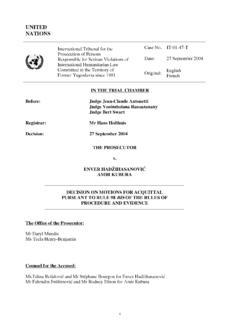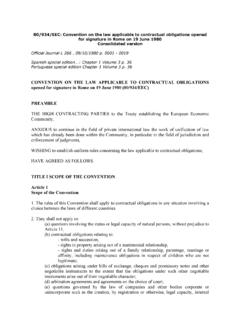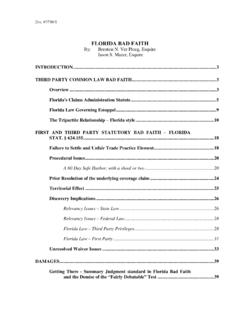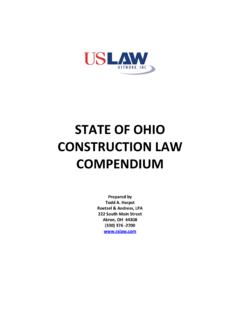Transcription of The Hague Conference on Private International Law
1 Hague JUSTICE JOURNAL I JOURNAL JUDICIAIRE DE LA HAYE VOLUME/VOLUME 2 I NUMBER/ NUM RO 2 I 2007 HJJ 2007 3 The Hague Conference on Private International Law * Hans van Loon 1 1. Introduction Among the International organisations at The Hague , the Hague Conference on Private International Law is unique in that it is the only intergovernmental organisation with a legislative mission. However, its laws take the form of multilateral treaties or conventions, which are not primarily aimed at facilitating the relations between States, but rather the lives of their citizens, Private and commercial, in cross-border relationships and transactions.
2 Although our world is increasingly interconnected, it is still composed of a great variety of legal systems, reflecting different traditions of Private and commercial relationships. When people cross borders or act in a country other than their own, these differences may unexpectedly complicate or even frustrate their actions. For example, in some countries marriages take place according to various religious forms, while other countries require a civil marriage; will either system give effect to the other s form of marriage? Two cars collide in Austria, injuring the passengers, all of whom are Turks; will Austrian or Turkish law apply in deciding damages or compensation?
3 A patent certificate issued in California must be produced for official use in Russia; is there a way to avoid cumbersome legalisation formalities? A London trustee wishes to acquire property; can he do so in Italy where trusts do not exist? A Moroccan-Dutch couple separates and the father takes their children to Morocco; does the wife have a remedy if her custody rights are ignored? There is an endless range of questions that may arise with regard to such cross-border situations. Solutions provided at the national, or even at the regional level, are increasingly insufficient in the light of progressing globalisation.
4 The task of the Hague Conference on Private International Law is to develop and service frameworks of multilateral legal instruments which, despite the differences between legal systems, will allow individuals as well as companies to enjoy a high degree of legal security. 1 Hans van Loon is the Secretary General of the Hague Conference on Private International Law. THE Hague Conference ON Private International LAW * HJJ I VOL. 2 I NO. 2 I 2007 4 2. Origins The Hague Conference is the oldest of the International legal institutions at The Hague .
5 The first Hague Conference was held in 1893 on the initiative of Tobias Asser (Nobel Peace Prize 1911). Initial attempts to convene such a Conference in Europe had failed, including one that was to have taken place in Rome in 1885, spurred by Pasquale Mancini, Asser s principal source of inspiration. It was only under Asser s initiative in 1893 that opportunities of time and venue were seized. In 1889 seven South American States had successfully concluded a diplomatic Conference on Private International law in Montevideo, and The Hague in the Netherlands offered a neutral place for Europe to respond with its own International Conference , free from powerful rivalries.
6 Moreover, Tobias Asser had the support not only of his Government but also of a group of eminent friends and colleagues from European countries, including Louis Renault (France), A. Pierantoni (Italy), and F. Martens (Russia). Their common vision was to remove legal obstacles to International Private relations and transactions through the negotiation of treaties, based on straightforward principles and acceptable to all nations. The first Hague Conference was so successful that it was immediately followed in 1894 by a second Diplomatic Conference . Once again, Asser presided over the Conference , with Fedor de Martens leading the negotiations for Russia.
7 Martens returned to Saint Petersburg impressed by these conferences and the importance of Asser s diplomacy in their success. There is no doubt that these factors played a role in his advising Czar Nicholas II to propose The Hague as the venue for the first Peace Conference in 1899, again to be chaired by Tobias Asser, with Fedor de Martens acting as aide-de-camp. The first Hague Peace Conference having been successfully completed, most notably by the creation of the Permanent Court of Arbitration, Asser went on to lead the third (1900) and fourth (1904) Hague Conferences on Private International law, each one organised on an ad hoc basis without the support of any permanent secretariat.
8 The 1904 Hague Conference welcomed Japan as the first non-European delegation. Together, these first four conferences produced seven Conventions: o Convention of 1896 relating to civil procedure (later replaced by that of 1905); o Convention of 12 June 1902 relating to the settlement of the conflict of the laws concerning marriage (replaced by the Marriage Convention of 1978); o Convention of 12 June 1902 relating to the settlement of the conflict of laws and jurisdictions concerning divorce and separation (replaced by the Divorce Convention of 1970).
9 O Convention of 12 June 1902 relating to the settlement of guardianship of minors (replaced by the Protection of Minors Convention of 1961 and now by the Convention on the Protection of Children of 1996); o Convention of 17 July 1905 relating to conflicts of laws with regard to the effects of marriage on the rights and duties of the spouses in their personal relationship and THE Hague Conference ON Private International LAW * HJJ I VOL. 2 I NO. 2 I 2007 5 with regard to their estates (replaced by the Matrimonial Property Regimes Convention of 1978); o Convention of 17 July 1905 relating to deprivation of civil rights and similar measures of protection (replaced by the Protection of Adults Convention of 2000).
10 O Convention of 17 July 1905 relating to civil procedure (replaced by the Convention on Civil Procedure of 1954, and the Service Convention of 1965, the Evidence Convention of 1970 and the Access to Justice Convention of 2000). The work stagnated after the Fourth Session when the International political climate deteriorated and perverted nationalism won ground in Europe, effectively discrediting nationality the cornerstone of most of the early Hague Conventions as any sort of guiding principle. Even before the First World War, countries had begun denouncing the conventions that they had so happily agreed upon a decade before.










